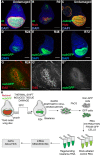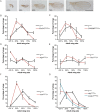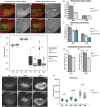The Drosophila Duox maturation factor is a key component of a positive feedback loop that sustains regeneration signaling
- PMID: 28753614
- PMCID: PMC5550008
- DOI: 10.1371/journal.pgen.1006937
The Drosophila Duox maturation factor is a key component of a positive feedback loop that sustains regeneration signaling
Abstract
Regenerating tissue must initiate the signaling that drives regenerative growth, and sustain that signaling long enough for regeneration to complete. How these key signals are sustained is unclear. To gain a comprehensive view of the changes in gene expression that occur during regeneration, we performed whole-genome mRNAseq of actively regenerating tissue from damaged Drosophila wing imaginal discs. We used genetic tools to ablate the wing primordium to induce regeneration, and carried out transcriptional profiling of the regeneration blastema by fluorescently labeling and sorting the blastema cells, thus identifying differentially expressed genes. Importantly, by using genetic mutants of several of these differentially expressed genes we have confirmed that they have roles in regeneration. Using this approach, we show that high expression of the gene moladietz (mol), which encodes the Duox-maturation factor NIP, is required during regeneration to produce reactive oxygen species (ROS), which in turn sustain JNK signaling during regeneration. We also show that JNK signaling upregulates mol expression, thereby activating a positive feedback signal that ensures the prolonged JNK activation required for regenerative growth. Thus, by whole-genome transcriptional profiling of regenerating tissue we have identified a positive feedback loop that regulates the extent of regenerative growth.
Conflict of interest statement
The authors have declared that no competing interests exist.
Figures








References
-
- Tanaka EM, Reddien PW. The cellular basis for animal regeneration. Dev Cell. 2011. July 19;21(1):172–85. doi: 10.1016/j.devcel.2011.06.016 - DOI - PMC - PubMed
-
- Hobmayer B, Rentzsch F, Kuhn K, Happel CM, Laue von CC, Snyder P, et al. WNT signalling molecules act in axis formation in the diploblastic metazoan Hydra. Nature. 2000. September 14;407(6801):186–9. doi: 10.1038/35025063 - DOI - PubMed
-
- Kawakami Y, Rodriguez Esteban C, Raya M, Kawakami H, Martí M, Dubova I, et al. Wnt/beta-catenin signaling regulates vertebrate limb regeneration. Genes Dev. 2006. December 1;20(23):3232–7. doi: 10.1101/gad.1475106 - DOI - PMC - PubMed
-
- Petersen CP, Reddien PW. Smed-betacatenin-1 is required for anteroposterior blastema polarity in planarian regeneration. Science. 2008. January 18;319(5861):327–30. doi: 10.1126/science.1149943 - DOI - PubMed
-
- Petersen CP, Reddien PW. A wound-induced Wnt expression program controls planarian regeneration polarity. Proc Natl Acad Sci USA. 2009. October 6;106(40):17061–6. doi: 10.1073/pnas.0906823106 - DOI - PMC - PubMed
MeSH terms
Substances
Grants and funding
LinkOut - more resources
Full Text Sources
Other Literature Sources
Molecular Biology Databases
Research Materials

